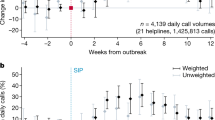Abstract
Obscene or nuisance phone calls are particularly targeted towards women. Employing data from two sweeps of the British Crime Survey a decade apart (BCS 1982 and BCS 1992), this work attempts to measure the effects of individual socio-economic characteristics and victimization history of women in England and Wales on their likelihood of receiving at least one nuisance call. To make the logit modelling analysis more tangible, risks of nuisance calls are calculated from our models of five hypothetical women, single mother, professional, student, housewife and pensioner, with specific attributes taken from the set of explanatory variables.
Similar content being viewed by others
REFERENCES
Buck, W., M. Chatterton and K. Pease, Obscene, Threatening and other Troublesome Telephone Calls to Women in England and Wales: 1982-1992. London: Home Office, 1995.
Chenery, S. and D. Ellingworth et al., Crimes which repeat: undigested evidence from the British Crime Survey 1992. International Journal of Risk, Security and Crime Prevention, 1(3), pp. 207-216, 1996.
Cohen, L.E. and M. Felson, Social change and crime rates trends: a routine activity approach. American Sociological Review, 44, pp. 588-608, 1979.
Hales, J., 1992 British Crime Survey (England and Wales) Technical Report. London: Social and Community Planning Research, 1993.
Hindelang, M.J., M.R. Gottfredson and J. Garofalo, Victims of Personal Crime: An Empirical Foundation for a Theory of Personal Victimization. Cambridge, Mass.: Ballinger Publishing Company, 1978.
Kennedy, L.W. and D.R. Forde, Routine activities and crime: an analysis of victimization in Canada. Criminology, 28(1), pp. 137-152, 1990.
Pease, K., Obscene telephone calls to women in England and Wales. Howard Journal of Criminal Justice, 24, pp. 275-281, 1985.
Norusis, M.J./SPSS Inc., SPSS Advanced Statistics 6.1. Chicago: SPSS Inc., 1994.
Sampson, R.J. and W.B. Groves, Community structure and crime: testing social disorganisation theory. American Journal of Sociology, 94(4), pp. 774-802, 1989.
Sampson, R.J. and J.D. Wooldredge, Linking the micro-and macro-level dimensions of lifestyle-routine activity and opportunity models of predatory victimization. Journal of Quantitative Criminology, 3(4), pp. 371-393, 1987.
Shaw, C.R. and M.D. McKay, Juvenile Delinquency and Urban Areas. Chicago: Chicago University Press, 1942.
Trickett, A., D.R. Osborn and D. Ellingworth, Property crime victimization: the roles of individual and area influences. International Review of Victimology, 3(4), pp. 273-295, 1995.
Tseloni, A., D.R. Osborn and K. Pease, The modelling of threats: evidence from the British Crime Survey. International Review of Victimology, 3(3), pp. 235-261, 1994.
Wood, D., British Crime Survey 1982; Technical Report. London: Home Office, 1984.
Author information
Authors and Affiliations
Rights and permissions
About this article
Cite this article
Tseloni, A., Pease, K. 'Nuisance' phone calls to women in England and Wales. European Journal on Criminal Policy and Research 6, 91–111 (1998). https://doi.org/10.1023/A:1008698918620
Issue Date:
DOI: https://doi.org/10.1023/A:1008698918620




